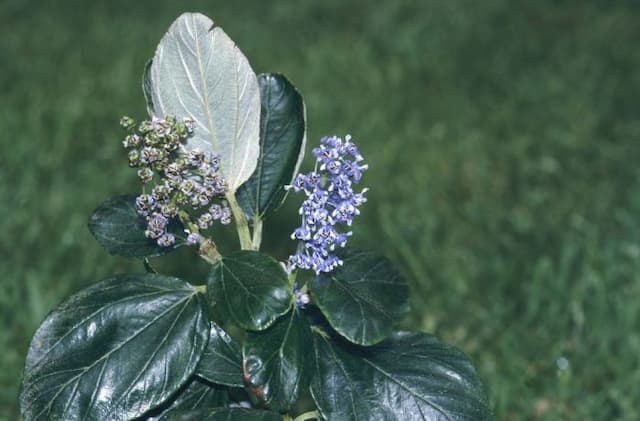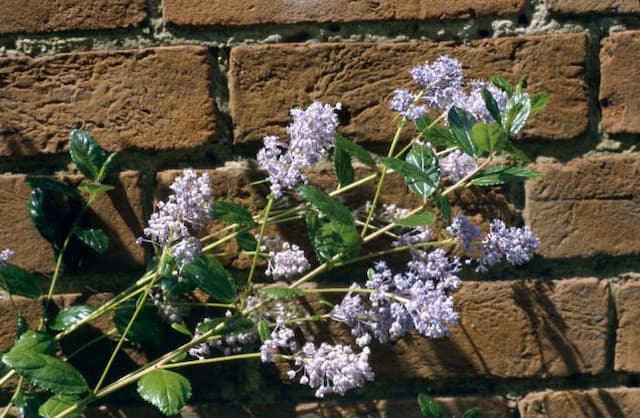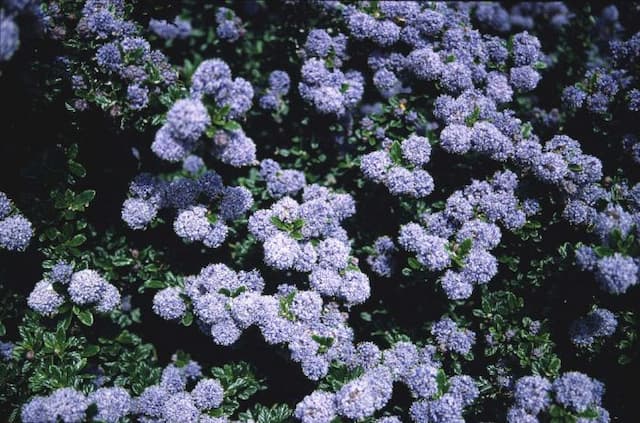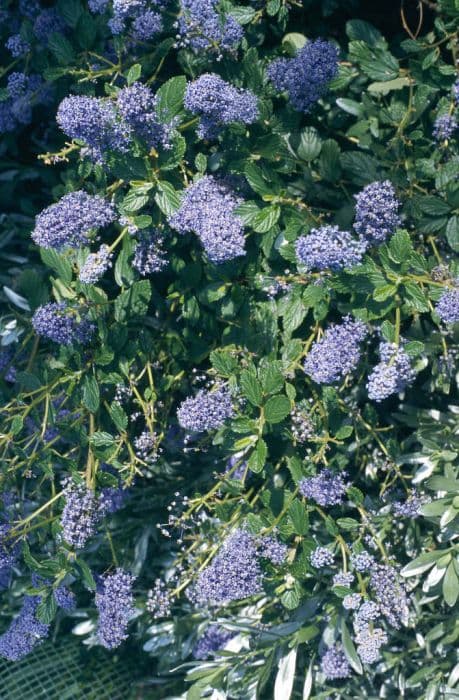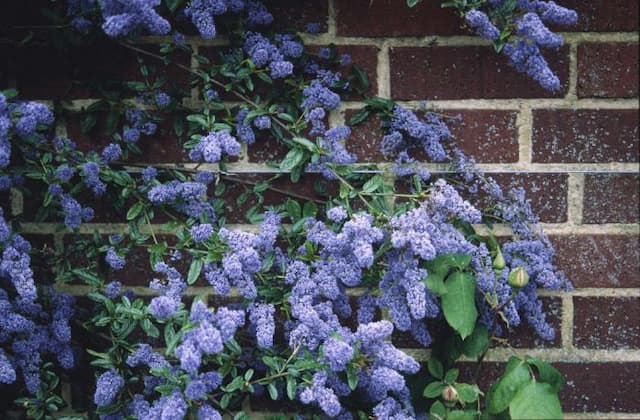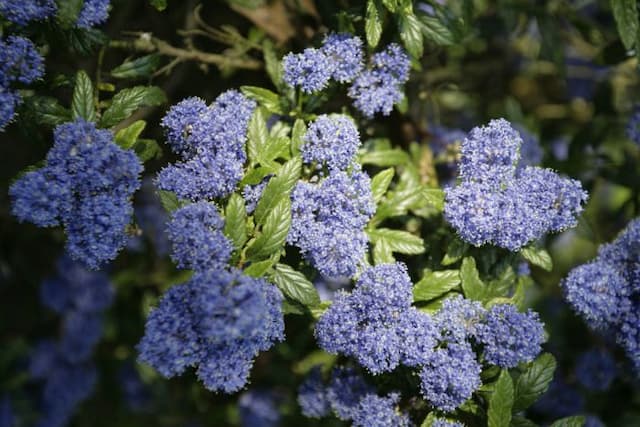Carmel Creeper Ceanothus griseus var. horizontalis 'Silver Surprise' (PBR) (v)

ABOUT
The 'Silver Surprise' California lilac, otherwise known as the Ceanothus griseus var. horizontalis 'Silver Surprise', is a visually striking shrub. This variety stands out with its unique foliage, characterized by deep green leaves contrasted with bold, creamy white edges, creating a variegated effect. The leaves themselves have a slight glossiness to them, inviting light to dance across their surfaces. During the blooming season, this California lilac bursts forth with an abundance of tiny, clustered flowers that are typically a rich blue hue. These blossoms are very attractive to bees and butterflies, making the 'Silver Surprise' not just a feast for the eyes, but also a hub of activity in the garden as it supports local pollinators. The combination of the brightly edged leaves and the vivid blue flowers provides a delightful contrast that can enhance the aesthetic appeal of any garden space. Overall, the 'Silver Surprise' California lilac is recognized for its decorative foliage and profuse flowering, which add both color and texture to the landscape.
About this plant
 Names
NamesFamily
Rhamnaceae.
Synonyms
Carmel Creeper, California Lilac, Horizontalis 'Silver Surprise'.
Common names
Ceanothus thyrsiflorus var. griseus 'Silver Surprise' (PBR) (v)
 Toxicity
ToxicityTo humans
The plant commonly known as Carmel creeper is not known to be toxic to humans. There is no widespread evidence indicating that ingesting Carmel creeper causes any significant poisoning symptoms in humans. However, it is always advisable to exercise caution and avoid ingesting plants that are not typically recognized as food sources, as individual reactions can vary.
To pets
The Carmel creeper is not listed as toxic to pets such as dogs and cats. It is generally considered safe around pets, with no significant reports of toxicity. However, as with humans, it's best to prevent pets from eating ornamental plants since they can cause gastrointestinal upset or other adverse reactions in some rare cases.
 Characteristics
CharacteristicsLife cycle
Perennials
Foliage type
Evergreen
Color of leaves
Variegated
Flower color
Blue
Height
2-3 feet (0.6-0.9 meters)
Spread
6-8 feet (1.8-2.4 meters)
Plant type
Shrub
Hardiness zones
8
Native area
California
Benefits
 General Benefits
General Benefits- Easy to grow – Adaptable to a variety of soils and conditions, requiring minimal maintenance once established.
- Drought tolerant – Once established, it requires little water, making it an excellent choice for water-wise gardens.
- Attracts wildlife – Provides nectar for pollinators such as bees and butterflies, enhancing biodiversity.
- Evergreen foliage – Offers year-round visual interest with its green leaves edged in creamy-white variegation.
- Ground cover – With its low, spreading habit it covers the ground effectively, suppressing weeds and reducing soil erosion.
- Landscape design – Its variegated foliage can provide a striking contrast to other plants in a garden design.
- Tolerates sea spray – Suitable for coastal gardens due to its tolerance of salty air and sea spray.
- Low hedge potential – Can be pruned and shaped into a low hedge for formal or informal garden borders.
- Fast-growing – Quickly establishes itself and covers ground, ideal for new gardens or areas needing renovation.
 Medical Properties
Medical PropertiesThis plant is not used for medical purposes.
 Air-purifying Qualities
Air-purifying QualitiesThis plant is not specifically known for air purifying qualities.
 Other Uses
Other Uses- Photography backdrop: The variegated foliage and mounding habit of California lilac can provide a beautifully textured green backdrop for close-up photography of insects or other small wildlife.
- Floral Arrangements: The dense foliage and blue flowers of California lilac can be used to create attractive and long-lasting floral arrangements.
- Erosion control: California lilac’s extensive root system can be used on slopes and hillsides to help prevent soil erosion.
- Livestock forage: In rural areas, the plant can be tolerated by some livestock and used as a supplemental food source, particularly goats.
- Educational tool: This plant can be used in school gardens to teach students about drought-tolerant landscaping and pollinator-friendly practices.
- Natural fencing: Due to its dense growth habit, California lilac can be planted in a row to create an effective visual barrier or living fence.
- Scented gardens: The plant's aromatic leaves can contribute to scented garden designs, where plants are chosen for their fragrance.
- Dye production: The flowers of California lilac can be used to create a light green dye for fabrics or crafts.
- Seasonal interest: With its evergreen foliage and seasonal blooms, it can be used in gardens to maintain year-round interest.
- Artistic inspiration: Artists may use the structure and color of California lilac as inspiration for paintings, drawings, or textile designs.
Interesting Facts
 Feng Shui
Feng ShuiThe California Lilac is not used in Feng Shui practice.
 Zodiac Sign Compitability
Zodiac Sign CompitabilityThe California Lilac is not used in astrology practice.
 Plant Symbolism
Plant Symbolism- Resilience: Ceanothus griseus, commonly known as the California Lilac, is a hardy plant that can withstand tough conditions, often symbolizing the ability to persevere and adapt.
- Endurance: This variety, with its ground-hugging habit, is often used for erosion control, signifying endurance and the ability to hold steady during difficult times.
- Hope: The bright flowers of California Lilac signify hope and an optimistic outlook for the future, as it brings vibrant color to the landscape after winter.
- Renewal: The prolific spring blooms are emblematic of renewal and the cycle of life, celebrating new beginnings.
- Beauty: Its ornamental value and 'Silver Surprise' variegation can represent admiration for natural beauty and the uplifting impact it has on the human spirit.
 Water
WaterThe California Lilac should be watered moderately, especially during dry spells. In the growing season, water the plant once every week with approximately 1 to 2 gallons, ensuring the soil is moist but not waterlogged. During the winter months when the plant is dormant, reduce watering frequency, providing just enough water to prevent the soil from drying out completely, which may be once every 2 to 4 weeks. Be cautious of overwatering as this can lead to root rot.
 Light
LightCalifornia Lilac thrives best in full sun, receiving at least 6 to 8 hours of direct sunlight daily. Plant it in a location that ensures plenty of sunlight for healthy growth and optimal flowering. Avoid heavily shaded areas which can hinder its growth and reduce flowering.
 Temperature
TemperatureCalifornia Lilac prefers a temperate climate and can tolerate a range of temperatures. It can survive brief periods of cold down to about 10 degrees Fahrenheit, but ideally, it should be kept in areas where the temperature remains above 20 degrees Fahrenheit. The ideal temperature range for maximum growth and blooming is between 50 and 75 degrees Fahrenheit.
 Pruning
PruningPrune California Lilac to maintain its shape and promote healthier, more robust growth. It's best to prune after the plant has finished blooming in late spring or early summer. Pruning too often or too late in the year can reduce the number of flowers, as it blooms on old wood. Remove any dead or crossed branches and shape the plant as desired.
 Cleaning
CleaningAs needed
 Soil
SoilThe Carmel Creeper (common name) thrives in well-draining soil with a pH range from 5.5 to 7.5. An optimal soil mix might include equal parts loam, sand, and compost to facilitate drainage and fertility. Adjust pH with lime if too acidic or sulfur if too alkaline.
 Repotting
RepottingCarmel Creeper does not require frequent repotting; it can typically be repotted every 2-3 years, or as needed when it outgrows its current container.
 Humidity & Misting
Humidity & MistingCarmel Creeper prefers moderate humidity levels, although it is quite adaptable and can tolerate both coastal conditions and drier inland climates.
 Suitable locations
Suitable locationsIndoor
Provide bright light, minimal water, and good air flow.
Outdoor
Well-drained soil, full sun to part shade, sheltered spot.
Hardiness zone
8-10 USDA
 Life cycle
Life cycleThe Carmel creeper begins life as a seed that, upon germinating, develops a root system and a small shoot that emerges from the soil. It quickly grows into a young plant with distinctive leaves, and as it matures, it forms a dense groundcover with horizontal branching. During the spring to early summer, it enters its reproductive stage, blooming with clusters of small, blue to violet flowers that attract pollinators. After pollination, the flowers develop into small seed capsules, which, when mature, release seeds to propagate the next generation. Throughout the growing season, it requires adequate sunlight, water, and well-drained soil to thrive. Carmel creeper has an evergreen habit, but in colder climates or under stress, it may partially shed leaves before entering a dormant phase during the winter, conserving resources until conditions improve for new growth in the spring.
 Propogation
PropogationPropogation time
Spring to Summer
The most popular method of propagating Ceanothus griseus var. horizontalis 'Silver Surprise', commonly known as the Carmel Creeper, is through semi-hardwood cuttings. This is typically done in late summer to early autumn. Cuttings should be taken from the current year's growth that has partially matured; the wood should be somewhat firm but still flexible. It's important to remove the lower leaves and possibly dip the cutting base in a rooting hormone for better results. The cuttings should then be placed in a well-draining potting mix, kept moist, and ideally placed in a location with indirect sunlight and a consistent temperature until roots develop. This can take several weeks to a few months depending on conditions.
